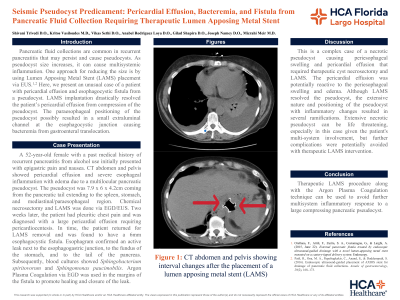Back


Poster Session A - Sunday Afternoon
Category: Interventional Endoscopy
A0441 - Seismic Pseudocyst Predicament: Pericardial Effusion, Bacteremia, and Fistula From Pancreatic Fluid Collection Requiring Therapeutic Lumen Apposing Metal Stent
Sunday, October 23, 2022
5:00 PM – 7:00 PM ET
Location: Crown Ballroom

Has Audio

Shivani Trivedi, DO
HCA Healthcare/USF Morsani College of Medicine GME, Largo Medical Center
Largo, FL
Presenting Author(s)
Shivani Trivedi, DO1, Vikas Sethi, DO2, Kritos Vasiloudes, MD3, Anabel Rodriguez Loya, DO4, Gilad Shapira, DO3, Meir Mizrahi, MD5, Joseph Namey, DO4
1HCA Healthcare/USF Morsani College of Medicine GME, Largo Medical Center, Largo, FL; 2HCA Healthcare, Clearwater, FL; 3HCA Healthcare, Largo, FL; 4Largo Medical Center, Largo, FL; 5HCA West Florida Largo Medical Center, Largo, FL
Introduction: Pancreatic fluid collections are common in episodes of recurrent pancreatitis that may persist and cause pseudocysts. As the size of pseudocyst increases, it can cause multisystemic inflammation. One of the therapeutic approaches for reducing the size is by using Lumen Apposing Metal Stent (LAMS) placement via EUS. Here we present an unusual case of a patient with pericardial effusion and esophagocystic fistula from a pseudocyst. While LAMS implantation drastically resolved the cyst’s size mitigating further complications, its original paraesophageal position and resultant edema induced a pericardial effusion and small extraluminal channel at the esophagocystic junction causing bacteremia from gastroenteral translocation..
Case Description/Methods: A 52-year-old female with a past medical history of recurrent pancreatitis from alcohol use initially presented with epigastric pain and nausea. CT abdomen and pelvis showed a pericardial effusion and severe esophageal inflammation with edema due to a multilocular pancreatic pseudocyst. The pseudocyst was 7.9 x 6 x 4.2cm emanating from the pancreatic tail extending to the spleen, stomach, and mediastinal/paraesophageal region. Chemical necrosectomy and LAMS was done via EGD/EUS. Two weeks later, the patient had pleuritic chest pain and was diagnosed with a large pericardial effusion requiring pericardiocentesis. Eventually, the patient returned for LAMS removal and was found to have a 6mm esophagocystic fistula. Esophagram confirmed an active leak next to the esophagogastric junction, to the fundus of the stomach, and to the tail of the pancreas. Subsequently, blood cultures showed Sphingobacterium spiritivorum and Sphingomonas paucimobilis. APC via EGD was used in the margins of the fistula to promote healing and closure of the leak.
Discussion: This is a complex case of a necrotic pseudocyst causing periesophageal swelling and pericardial effusion that required therapeutic cyst necrosectomy and LAMS. The pericardial effusion was potentially reactive to the periesophageal swelling and edema. Although LAMS resolved the pseudocyst, the extensive nature and positioning of the pseudocyst with inflammatory changes resulted in several ramifications. Extensive necrotic pseudocyst can be life threatening, especially in this case given the patient's multi-system involvement, but further complications were potentially avoided with therapeutic LAMS intervention.
Disclosures:
Shivani Trivedi, DO1, Vikas Sethi, DO2, Kritos Vasiloudes, MD3, Anabel Rodriguez Loya, DO4, Gilad Shapira, DO3, Meir Mizrahi, MD5, Joseph Namey, DO4. A0441 - Seismic Pseudocyst Predicament: Pericardial Effusion, Bacteremia, and Fistula From Pancreatic Fluid Collection Requiring Therapeutic Lumen Apposing Metal Stent, ACG 2022 Annual Scientific Meeting Abstracts. Charlotte, NC: American College of Gastroenterology.
1HCA Healthcare/USF Morsani College of Medicine GME, Largo Medical Center, Largo, FL; 2HCA Healthcare, Clearwater, FL; 3HCA Healthcare, Largo, FL; 4Largo Medical Center, Largo, FL; 5HCA West Florida Largo Medical Center, Largo, FL
Introduction: Pancreatic fluid collections are common in episodes of recurrent pancreatitis that may persist and cause pseudocysts. As the size of pseudocyst increases, it can cause multisystemic inflammation. One of the therapeutic approaches for reducing the size is by using Lumen Apposing Metal Stent (LAMS) placement via EUS. Here we present an unusual case of a patient with pericardial effusion and esophagocystic fistula from a pseudocyst. While LAMS implantation drastically resolved the cyst’s size mitigating further complications, its original paraesophageal position and resultant edema induced a pericardial effusion and small extraluminal channel at the esophagocystic junction causing bacteremia from gastroenteral translocation..
Case Description/Methods: A 52-year-old female with a past medical history of recurrent pancreatitis from alcohol use initially presented with epigastric pain and nausea. CT abdomen and pelvis showed a pericardial effusion and severe esophageal inflammation with edema due to a multilocular pancreatic pseudocyst. The pseudocyst was 7.9 x 6 x 4.2cm emanating from the pancreatic tail extending to the spleen, stomach, and mediastinal/paraesophageal region. Chemical necrosectomy and LAMS was done via EGD/EUS. Two weeks later, the patient had pleuritic chest pain and was diagnosed with a large pericardial effusion requiring pericardiocentesis. Eventually, the patient returned for LAMS removal and was found to have a 6mm esophagocystic fistula. Esophagram confirmed an active leak next to the esophagogastric junction, to the fundus of the stomach, and to the tail of the pancreas. Subsequently, blood cultures showed Sphingobacterium spiritivorum and Sphingomonas paucimobilis. APC via EGD was used in the margins of the fistula to promote healing and closure of the leak.
Discussion: This is a complex case of a necrotic pseudocyst causing periesophageal swelling and pericardial effusion that required therapeutic cyst necrosectomy and LAMS. The pericardial effusion was potentially reactive to the periesophageal swelling and edema. Although LAMS resolved the pseudocyst, the extensive nature and positioning of the pseudocyst with inflammatory changes resulted in several ramifications. Extensive necrotic pseudocyst can be life threatening, especially in this case given the patient's multi-system involvement, but further complications were potentially avoided with therapeutic LAMS intervention.
Disclosures:
Shivani Trivedi indicated no relevant financial relationships.
Vikas Sethi indicated no relevant financial relationships.
Kritos Vasiloudes indicated no relevant financial relationships.
Anabel Rodriguez Loya indicated no relevant financial relationships.
Gilad Shapira indicated no relevant financial relationships.
Meir Mizrahi indicated no relevant financial relationships.
Joseph Namey indicated no relevant financial relationships.
Shivani Trivedi, DO1, Vikas Sethi, DO2, Kritos Vasiloudes, MD3, Anabel Rodriguez Loya, DO4, Gilad Shapira, DO3, Meir Mizrahi, MD5, Joseph Namey, DO4. A0441 - Seismic Pseudocyst Predicament: Pericardial Effusion, Bacteremia, and Fistula From Pancreatic Fluid Collection Requiring Therapeutic Lumen Apposing Metal Stent, ACG 2022 Annual Scientific Meeting Abstracts. Charlotte, NC: American College of Gastroenterology.
